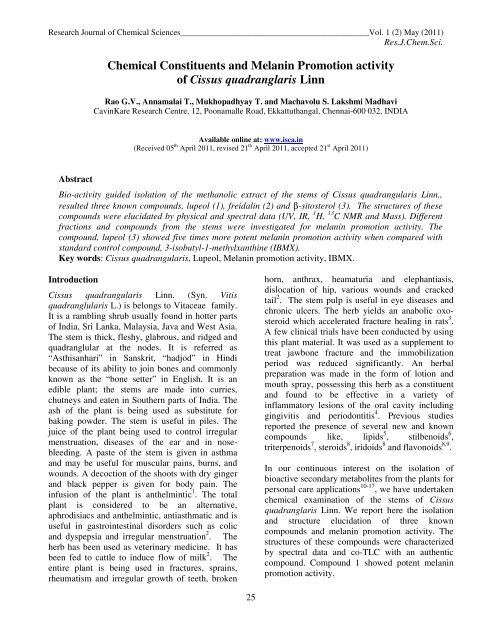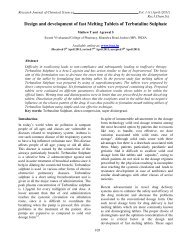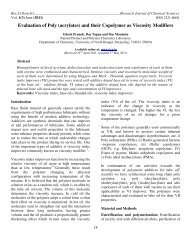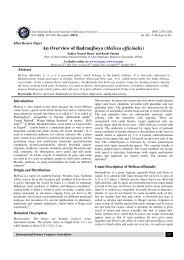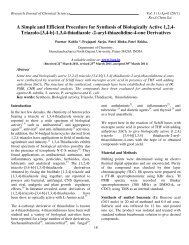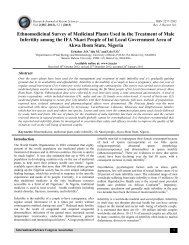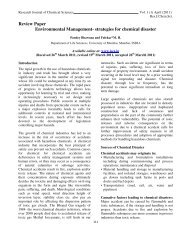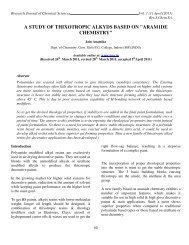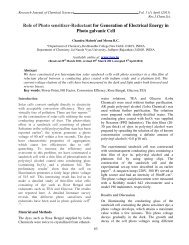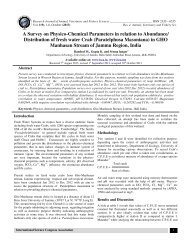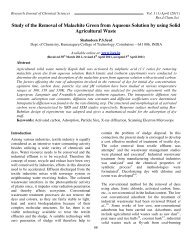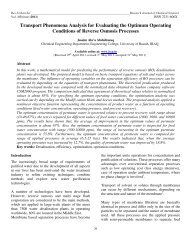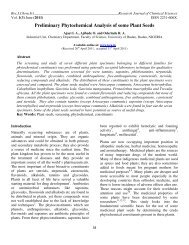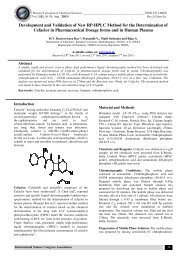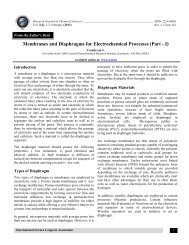Chemical Constituents and Melanin Promotion activity of ... - ISCA
Chemical Constituents and Melanin Promotion activity of ... - ISCA
Chemical Constituents and Melanin Promotion activity of ... - ISCA
You also want an ePaper? Increase the reach of your titles
YUMPU automatically turns print PDFs into web optimized ePapers that Google loves.
Research Journal <strong>of</strong> <strong>Chemical</strong> Sciences_____________________________________________Vol. 1 (2) May (2011)<br />
Res.J.Chem.Sci.<br />
<strong>Chemical</strong> <strong>Constituents</strong> <strong>and</strong> <strong>Melanin</strong> <strong>Promotion</strong> <strong>activity</strong><br />
<strong>of</strong> Cissus quadranglaris Linn<br />
Rao G.V., Annamalai T., Mukhopadhyay T. <strong>and</strong> Machavolu S. Lakshmi Madhavi<br />
CavinKare Research Centre, 12, Poonamalle Road, Ekkattuthangal, Chennai-600 032, INDIA<br />
Available online at: www.isca.in<br />
(Received 05 th April 2011, revised 21 th April 2011, accepted 21 st April 2011)<br />
Abstract<br />
Bio-<strong>activity</strong> guided isolation <strong>of</strong> the methanolic extract <strong>of</strong> the stems <strong>of</strong> Cissus quadrangularis Linn.,<br />
resulted three known compounds, lupeol (1), freidalin (2) <strong>and</strong> β-sitosterol (3). The structures <strong>of</strong> these<br />
compounds were elucidated by physical <strong>and</strong> spectral data (UV, IR, 1 H, 13 C NMR <strong>and</strong> Mass). Different<br />
fractions <strong>and</strong> compounds from the stems were investigated for melanin promotion <strong>activity</strong>. The<br />
compound, lupeol (3) showed five times more potent melanin promotion <strong>activity</strong> when compared with<br />
st<strong>and</strong>ard control compound, 3-isobutyl-1-methylxanthine (IBMX).<br />
Key words: Cissus quadrangularis, Lupeol, <strong>Melanin</strong> promotion <strong>activity</strong>, IBMX.<br />
Introduction<br />
Cissus quadrangularis Linn. (Syn. Vitis<br />
quadranglularis L.) is belongs to Vitaceae family.<br />
It is a rambling shrub usually found in hotter parts<br />
<strong>of</strong> India, Sri Lanka, Malaysia, Java <strong>and</strong> West Asia.<br />
The stem is thick, fleshy, glabrous, <strong>and</strong> ridged <strong>and</strong><br />
quadranglular at the nodes. It is referred as<br />
“Asthisanhari” in Sanskrit, “hadjod” in Hindi<br />
because <strong>of</strong> its ability to join bones <strong>and</strong> commonly<br />
known as the “bone setter” in English. It is an<br />
edible plant; the stems are made into curries,<br />
chutneys <strong>and</strong> eaten in Southern parts <strong>of</strong> India. The<br />
ash <strong>of</strong> the plant is being used as substitute for<br />
baking powder. The stem is useful in piles. The<br />
juice <strong>of</strong> the plant being used to control irregular<br />
menstruation, diseases <strong>of</strong> the ear <strong>and</strong> in nosebleeding.<br />
A paste <strong>of</strong> the stem is given in asthma<br />
<strong>and</strong> may be useful for muscular pains, burns, <strong>and</strong><br />
wounds. A decoction <strong>of</strong> the shoots with dry ginger<br />
<strong>and</strong> black pepper is given for body pain. The<br />
infusion <strong>of</strong> the plant is anthelmintic 1 . The total<br />
plant is considered to be an alternative,<br />
aphrodisiacs <strong>and</strong> anthelmintic, antiasthmatic <strong>and</strong> is<br />
useful in gastrointestinal disorders such as colic<br />
<strong>and</strong> dyspepsia <strong>and</strong> irregular menstruation 2 . The<br />
herb has been used as veterinary medicine. It has<br />
been fed to cattle to induce flow <strong>of</strong> milk 2 . The<br />
entire plant is being used in fractures, sprains,<br />
rheumatism <strong>and</strong> irregular growth <strong>of</strong> teeth, broken<br />
horn, anthrax, heamaturia <strong>and</strong> elephantiasis,<br />
dislocation <strong>of</strong> hip, various wounds <strong>and</strong> cracked<br />
tail 2 . The stem pulp is useful in eye diseases <strong>and</strong><br />
chronic ulcers. The herb yields an anabolic oxosteroid<br />
which accelerated fracture healing in rats 3 .<br />
A few clinical trials have been conducted by using<br />
this plant material. It was used as a supplement to<br />
treat jawbone fracture <strong>and</strong> the immobilization<br />
period was reduced significantly. An herbal<br />
preparation was made in the form <strong>of</strong> lotion <strong>and</strong><br />
mouth spray, possessing this herb as a constituent<br />
<strong>and</strong> found to be effective in a variety <strong>of</strong><br />
inflammatory lesions <strong>of</strong> the oral cavity including<br />
gingivitis <strong>and</strong> periodontitis 4 . Previous studies<br />
reported the presence <strong>of</strong> several new <strong>and</strong> known<br />
compounds like, lipids 5 , stilbenoids 6 ,<br />
triterpenoids 7 , steroids 8 , iridoids 8 <strong>and</strong> flavonoids 8,9 .<br />
In our continuous interest on the isolation <strong>of</strong><br />
bioactive secondary metabolites from the plants for<br />
personal care applications 10-17 , we have undertaken<br />
chemical examination <strong>of</strong> the stems <strong>of</strong> Cissus<br />
quadranglaris Linn. We report here the isolation<br />
<strong>and</strong> structure elucidation <strong>of</strong> three known<br />
compounds <strong>and</strong> melanin promotion <strong>activity</strong>. The<br />
structures <strong>of</strong> these compounds were characterized<br />
by spectral data <strong>and</strong> co-TLC with an authentic<br />
compound. Compound 1 showed potent melanin<br />
promotion <strong>activity</strong>.<br />
25
Research Journal <strong>of</strong> <strong>Chemical</strong> Sciences_____________________________________________Vol. 1 (2) May (2011)<br />
Res.J.Chem.Sci.<br />
Material <strong>and</strong> Methods<br />
General procedures: Melting points were<br />
reported are uncorrected. 1 H-NMR, 13 C NMR<br />
spectra were recorded on Bruker spectrometer in<br />
CDCl 3 , operating at 400MHz for 1 H-NMR <strong>and</strong> 100<br />
MHZ for 13 C NMR. EI mass was recorded on Jeol<br />
SX 102/DA 600 mass spectrometer. IR spectra<br />
were recorded on a Shimadzu IR Prestige 21. UV<br />
spectra were recorded on Shimadzu UV<br />
spectrophotometer. Column chromatography (CC)<br />
was carried on a silica gel column (100-200 mesh).<br />
Purity <strong>of</strong> the samples was checked by TLC on precoated<br />
aluminum sheets, silica gel 60 F 254 (20 X 20<br />
cm, 0.2 mm thickness, Merck) <strong>and</strong> compounds<br />
were detected by spraying with 5% sulphuric acid<br />
in methanol followed by heating the plates at<br />
110 o C for 5 min. The chemical shift values are<br />
reported in ppm (δ) units <strong>and</strong> the coupling<br />
constants (J) are in Hz. For melanin promotion<br />
assay, all chemicals <strong>and</strong> IBMX were purchased<br />
from Sigma (USA).<br />
Plant material: The stems <strong>of</strong> Cissus<br />
quadrangularis Linn., (510 g) were collected from<br />
Padappai, near Chennai, Tamil Nadu, during<br />
January 2009. The plant was authenticated by Dr.<br />
P. Santhan, Plant Taxonomist, Durva Herbal<br />
Centre, Chennai, India. A voucher specimen <strong>of</strong> this<br />
plant was deposited in Cavinkare Research Centre,<br />
Chennai, India.<br />
The powdered stems were exhaustively extracted<br />
with methanol (3.0 L) by using soxhlet apparatus<br />
for 8 hrs. After evaporation <strong>of</strong> the solvent under<br />
reduced pressure, 32.45 g crude extract was<br />
obtained <strong>and</strong> showed an excellent melanin<br />
promotion <strong>activity</strong> (380% at 50µg/ml). The crude<br />
methanolic extract was subjected to silica gel<br />
vacuum liquid chromatography (100-200 mesh, 80<br />
g), using solvents such as hexane, hexane : ethyl<br />
acetate (19:1, 18:2, 16:4, 1:1), ethyl acetate <strong>and</strong><br />
methanol to get corresponding fractions 0.4 g<br />
(Fr.1), 1.46 g (Fr. 2), 1.50 g (Fr. 3), 1.61 g (Fr. 4)<br />
2.0 g (Fr.5), 5.0g (Fr.6) <strong>and</strong> 21.0g (Fr.7)<br />
respectively. All seven fractions were submitted<br />
for biological studies. Fr. 2 showed an excellent<br />
melanin promotion <strong>activity</strong> whereas Fr. 4 showed<br />
moderate <strong>activity</strong>.<br />
The resulting dark green residue <strong>of</strong> Fr. 2 showed<br />
solid in nature <strong>and</strong> its TLC showed mixture <strong>of</strong> two<br />
compounds. The fraction was purified by small<br />
silica gel column eluted with hexane: chlor<strong>of</strong>orm<br />
(1:1) <strong>and</strong> obtained two compounds, 1 (60 mg) <strong>and</strong><br />
2 (65 mg). The moderately active fraction, Fr.4<br />
was found to be solid in nature, crystallized with<br />
methanol <strong>and</strong> obtained compound 3 (305 mg). All<br />
three compounds were submitted for biological<br />
<strong>activity</strong> <strong>and</strong> compound 1 showed melanin<br />
promotion <strong>activity</strong>.<br />
Results <strong>and</strong> Discussion<br />
Compound 1 (Lupeol): Crystallized from hexane:<br />
ethyl acetate, mp: 194-99 ο C. UV (CHCl 3 , γ max in<br />
nm): 215nm; IR (KBr, ν max in cm -1 ): 2850, 1620,<br />
1400, 980; 1 H NMR (CDCl 3 ): δ 0.77 (3H, s, H-<br />
24), 0.82 (3H, s, H-28), 0.86 (3H, s, H-25), 0.94<br />
(3H, s, H-27), 0.95 (3H, s, H-23), 1.04 (3H, s, H-<br />
26), 1.69 (3H, s, H-30), 2.40 (1H, ddd, J=5.6, 11.0,<br />
11.0 Hz, H-19), 3.20 (1H, dd, J =5.1, 11.5 Hz, H-<br />
3), 4.57 (1H, d, J =1.3 Hz, H-29), 4.69 (1H, d, J=<br />
1.3 Hz, H-29); 13 C NMR (CDCl 3 ): δ 38.6 (C-1),<br />
27.3 (C-2), 78.9 (C-3), 38.9 (C-4), 55.2 (C-5), 18.2<br />
(C-6), 34.2 (C-7), 40.7 (C-8), 50.3 (C-9), 37.1 (C-<br />
10), 20.8 (C-11), 25.0 (C-12), 38.7 (C-13), 42.7<br />
(C-14), 27.9 (C-15), 35.4 (C-16), 42.9 (C-17), 48.2<br />
(C-18), 47.9 (C-19), 150.9 (C-20), 29.7 (C-21),<br />
39.9 (C-22), 27.9 (C-23), 15.3 (C-24), 16.0 (C-25),<br />
15.9 (C-26), 14.5 (C-27), 17.9 (C-28), 109.3 (C-<br />
29), 19.3 (C-30). EI-MS (m/z): 426 [M] + , 411, 408,<br />
393, 218, 207, 189.<br />
Compound 2 (Friedalin): Crystallized from<br />
hexane, mp: 258-60 ο C. UV (CHCl 3 , γ max in nm):<br />
215 nm, IR (KBr, ν max in cm -1 ): 2855, 1710 (C=O),<br />
1461 <strong>and</strong> 1380, 980; 1 H NMR (CDCl 3 ): δ 0.73<br />
(3H, s), 0.88 (3H, d, J= 6.7 Hz), 0.87 (3H, s), 0.96<br />
(3H, s), 1.00 (3H, s), 1.01 (3H, s), 1.05 (3H, s),<br />
1.18 (3H, s), 2.39 (1H, m); 13 C NMR (CDCl 3 ):<br />
δ 22.30 (C-1), 41.51 (C-2), 213.28 (C-3), 58.19 (C-<br />
4), 42.13 (C-5), 41.51 (C-6), 18.24 (C-7), 53.07 (C-<br />
8), 37.41 (C-9), 59.42 (C-10), 35.72 (C-11), 30.54<br />
(C-12), 38.26 (C-13), 39.67 (C-14), 32.44 (C-15),<br />
36.09 (C-16), 29.97 (C-17), 42.74 (C-18), 35.43<br />
(C-19), 28.16 (C-20), 32.73 (C-21), 39.25 (C-22),<br />
6.82 (C-23), 14.64 (C-24), 17.93 (C-25), 18.65 (C-<br />
26), 20.24 (C-27), 32.07 (C-28), 35.06 (C-29),<br />
26
Research Journal <strong>of</strong> <strong>Chemical</strong> Sciences_____________________________________________Vol. 1 (2) May (2011)<br />
Res.J.Chem.Sci.<br />
31.68 (C-30). EI-MS (m/z): 426 [M] + , 411, 398,<br />
302, 273, 218, 205, 163, 123, 95, 69, 44.<br />
Compound 3 (β-sitosterol): Crystallized from<br />
methanol, mp: 137-40 ο C. UV (CHCl 3 , γ max in nm):<br />
214 nm; IR (KBr, ν max in cm -1 ): 3500-3300 (OH),<br />
2940, 2860, 1640, 1380, 1060, 1020, 970, 960,<br />
800; 1 H NMR (CDCl 3 ): δ 0.68 (3Η, s), 0.82 (3H,<br />
d, J =7.5 Hz), 0.84 (6H, d, J =7.8 Hz), 0.92 (3H, d,<br />
J= 5.08 Hz), 1.01 (3H, s), 3.51 (1H, br m), 5.36<br />
(1H, br s), 13 C NMR (CDCl 3 ): δ 37.24 (C-1),<br />
31.56 (C-2), 71.79 (C-3), 42.29 (C-4), 140.75 (C-5)<br />
121.7 (C-6), 31.85 (C-7), 31.85 (C-8), 50.12 (C-9),<br />
36.49 (C-10), 21.07 (C-11), 39.76 (C-12), 42.30<br />
(C-13), 56.75 (C-14), 24.28 (C-15), 28.23 (C-16),<br />
56.04 (C-17), 11.87 (C-18), 19.38 (C-19), 36.13<br />
(C-20), 19.02 (C-21), 33.92 (C-22), 29.11 (C-23),<br />
45.82 (C-24), 26.05 (C-25), 18.76 (C-26), 19.81<br />
(C-27), 23.05 (C-28), 11.97 (C−29). EI-MS(m/z):<br />
414 [M + ], 396, 381, 273, 255, 231, 213.<br />
<strong>Melanin</strong> promotion <strong>activity</strong>: The melanin<br />
promotion <strong>activity</strong> 18 <strong>of</strong> different fractions <strong>of</strong><br />
methanolic extract along with its crude extract <strong>and</strong><br />
IBMX (control) were studied in cell lines (B16F10<br />
melanoma). The assay method is most precise <strong>and</strong><br />
reliable. The crude methanolic extract, fractions 2<br />
<strong>and</strong> 4 <strong>and</strong> lupeol (1) were showed significant<br />
<strong>activity</strong> by producing the more melanin in the cells<br />
(table 1).<br />
Conclusion<br />
Friedalin <strong>and</strong> β−sitosterol 19 have already been<br />
reported from this plant while lupeol 20 is being<br />
reported for the first time from this plant. The<br />
study <strong>of</strong> the melanin promotion <strong>activity</strong> is also first<br />
time for this plant.<br />
Acknowledgements<br />
Mr. C. K. Ranganathan, CMD <strong>of</strong> CavinKare Pvt.<br />
Ltd., Chennai for his interest, constant<br />
encouragement <strong>and</strong> providing the necessary<br />
facilities. We are also thankful to Mr. S.<br />
Lavakumar <strong>and</strong> Dr. T. Muthumani <strong>of</strong> M/s.<br />
CavinKare Pvt. Ltd., for providing the analytical<br />
support.<br />
References<br />
1. The wealth <strong>of</strong> India, Raw materials, CSIR,<br />
New Delhi, 3, 593-594 (1992)<br />
2. Williamson E.M., Major herbs <strong>of</strong> Ayurveda<br />
Churchil Livingsotone, New York, 106-109<br />
(2002)<br />
3. Asolkar L.V., Kakkar K.K. <strong>and</strong> Chakre O.J.,<br />
Second supplement to Glossary <strong>of</strong> Indian<br />
Medicinal Plants with Active Principals, CSIR,<br />
New Delhi, 206 (1992)<br />
4. Sharma P.C., Yelne M.B., Dennis T.J., Aruna<br />
Joshi, Prabhune Y.S. <strong>and</strong> Borkar G.B., Data<br />
base on medicinal Plants used in Ayurveda,<br />
Central Council for Research in Ayurveda <strong>and</strong><br />
Siddha, New Delhi 1, 43-49 (2000)<br />
5. Gupta M.M. <strong>and</strong> Verma R.K., Lipid<br />
constituents <strong>of</strong> Cissus quadrangulari,.<br />
Phytochem, 30, 875-78 (1991)<br />
6. Adesanya S.A., Nia R., Martin M.T.,<br />
Boukamcha N., Montagnac A. <strong>and</strong> Pias M.,<br />
Stilbene derivatives from Cissus<br />
quadrangularis, J. Nat. Prod., 62, 1694-1695<br />
(1999)<br />
7. Mehta M, Kaur N. <strong>and</strong> Bhutani K.K.,<br />
Determination <strong>of</strong> marker constituents from<br />
Cissus quadrangularis Linn <strong>and</strong> their<br />
quantification by HPTLC <strong>and</strong> HPLC,<br />
Phytochem. Anal., 12, 91-95 (2001)<br />
8. Singh G., Rawat P. <strong>and</strong> Maurya R.,<br />
<strong>Constituents</strong> <strong>of</strong> Cissus quadrangularis, Nat.<br />
Prod. Res., 21, 522-528 (2007)<br />
9. Thakur A., Jain V., Hingorani L. <strong>and</strong> Laddha<br />
K.S., Phytochemical Studies on Cissus<br />
quadrangularis Linn., Pharmcog. Res., 1, 213-<br />
215 (2009)<br />
10. Rao G.V., The chemical constituents <strong>and</strong><br />
biological studies <strong>of</strong> Chloroxylon swietenia<br />
DC. A review, Indian Drugs, 45, 5-15 (2008)<br />
27<br />
11. Rao G.V., Annamalai T. <strong>and</strong> Mukhopadhyay<br />
T., Nardal, a new sesquiterepene aldehyde
Research Journal <strong>of</strong> <strong>Chemical</strong> Sciences_____________________________________________Vol. 1 (2) May (2011)<br />
Res.J.Chem.Sci.<br />
from the plant, Nardostachys jatamansi DC,<br />
Ind. J. Chem., 47B, 163-165 (2008)<br />
12. Rao G.V., Rao K.S., Annamalai T., <strong>and</strong><br />
Mukhopadhyay T., New coumarin diol from<br />
the plant, Chloroxylon swietenia DC, Ind. J.<br />
Chem., 48B, 1041-1044 (2009)<br />
13. Rao G.V., <strong>Chemical</strong> constituents <strong>of</strong> Adiantum<br />
genus: A review, Indian Drugs, 45, 837-858<br />
(2008)<br />
14. Rao G.V., Rao K.S., Annamalai T. <strong>and</strong><br />
Mukhopadhyay T., <strong>Chemical</strong> constituents <strong>and</strong><br />
mushroom tyrosinase inhibition <strong>activity</strong> <strong>of</strong><br />
Chloroxylon swietenia leaves, Turk. J. Chem.,<br />
33, 521-526 (2009)<br />
15. Rao G.V., Mukhopadhyay T. <strong>and</strong><br />
Radhakrishnan N., Artoindonesianin F a potent<br />
tyrosinase inhibitor from the roots <strong>of</strong> A.<br />
heterophyllus Lam., Ind. J. Chem., 49B, 1264-<br />
1266 (2010)<br />
16. Rao G.V., Radhakrishanan N. <strong>and</strong><br />
Mukhopadhyay T., Improved cosmetic skin<br />
lightening composition, Indian Patent Appl.<br />
No.1727/ CHE (2007)<br />
17. Rao G.V., Mukhopadhyay T. <strong>and</strong> Rajesh G.D.,<br />
Skincare compositions from Mangifera Indica,<br />
Indian Patent Appl. No.2138/CHE (2007)<br />
18. Lee J., Jung E., Park J., Park B., Jung K., Park<br />
E, et al., Glycyrrhin induces melanogenesis by<br />
elevating a cAMP level in B16 melanoma cells,<br />
J. Invest. Dermatol., 124, 405-411 (2005)<br />
19. Boonyaratavej S. <strong>and</strong> Petsom A., A chemical<br />
constituents <strong>of</strong> the roots <strong>of</strong> Bridelia tomentosa,<br />
J. Sci. Soc. Thail<strong>and</strong>., 17, 61-69 (1991)<br />
20. Aratanechemuge Y., Hibasami H., Sanpin K.,<br />
Katsujaki H., Mai K. <strong>and</strong> Komiya T.,<br />
Induction <strong>of</strong> apoptosis by lupeolisolated from<br />
mokumen Gossampinus malabarica L. Merr<br />
inhuman promyelotic leukemia HL-60 cells,<br />
Oncol. Rep., 11, 289-292 (2004)<br />
Table-1: Intro <strong>Melanin</strong> <strong>Promotion</strong> Activity<br />
Compound / fraction Concentration (µg/ml) % <strong>Melanin</strong> promotion<br />
Methanolic extract 50 380<br />
Fr.2 25 150<br />
Fr.4 25 53<br />
IBMX (Control) 15 70<br />
Lupeol (1) 15 401<br />
Friedalin (2) 50 Not Active<br />
β-Sitosterol (3) 50 Not Active<br />
28
Research Journal <strong>of</strong> <strong>Chemical</strong> Sciences_____________________________________________Vol. 1 (2) May (2011)<br />
Res.J.Chem.Sci.<br />
29<br />
29 30<br />
HO<br />
25<br />
1<br />
2 10<br />
3<br />
4<br />
23 24<br />
30<br />
12 H<br />
11 13<br />
26<br />
14<br />
9<br />
8<br />
27<br />
5 6 7<br />
1<br />
20<br />
21<br />
19<br />
18<br />
17<br />
16<br />
15<br />
22<br />
28<br />
O<br />
1<br />
2<br />
3<br />
4<br />
23<br />
20<br />
19<br />
27<br />
12<br />
18<br />
11<br />
13 17<br />
9<br />
14<br />
10 8<br />
16<br />
15<br />
5 25<br />
6<br />
7 26<br />
24<br />
2<br />
21<br />
22<br />
28<br />
2<br />
1<br />
18<br />
10<br />
9<br />
11<br />
12<br />
8<br />
21<br />
19<br />
13<br />
14<br />
20<br />
17<br />
16<br />
15<br />
22<br />
24<br />
28<br />
23<br />
25<br />
29<br />
26<br />
27<br />
HO<br />
3<br />
5<br />
6<br />
7<br />
3<br />
Fig 1: Structures <strong>of</strong> three compounds isolated from Cissus quadrangularis<br />
29


